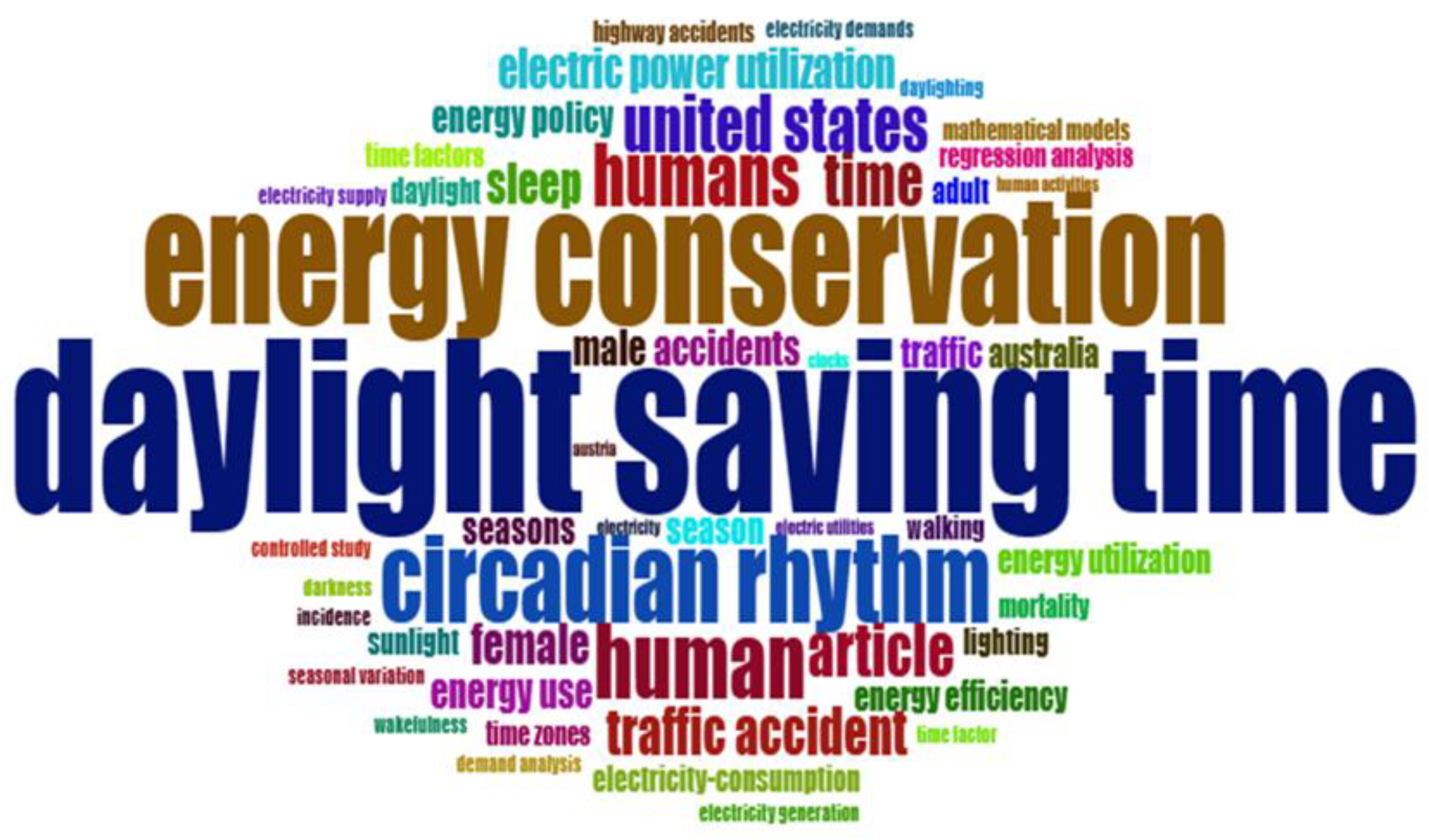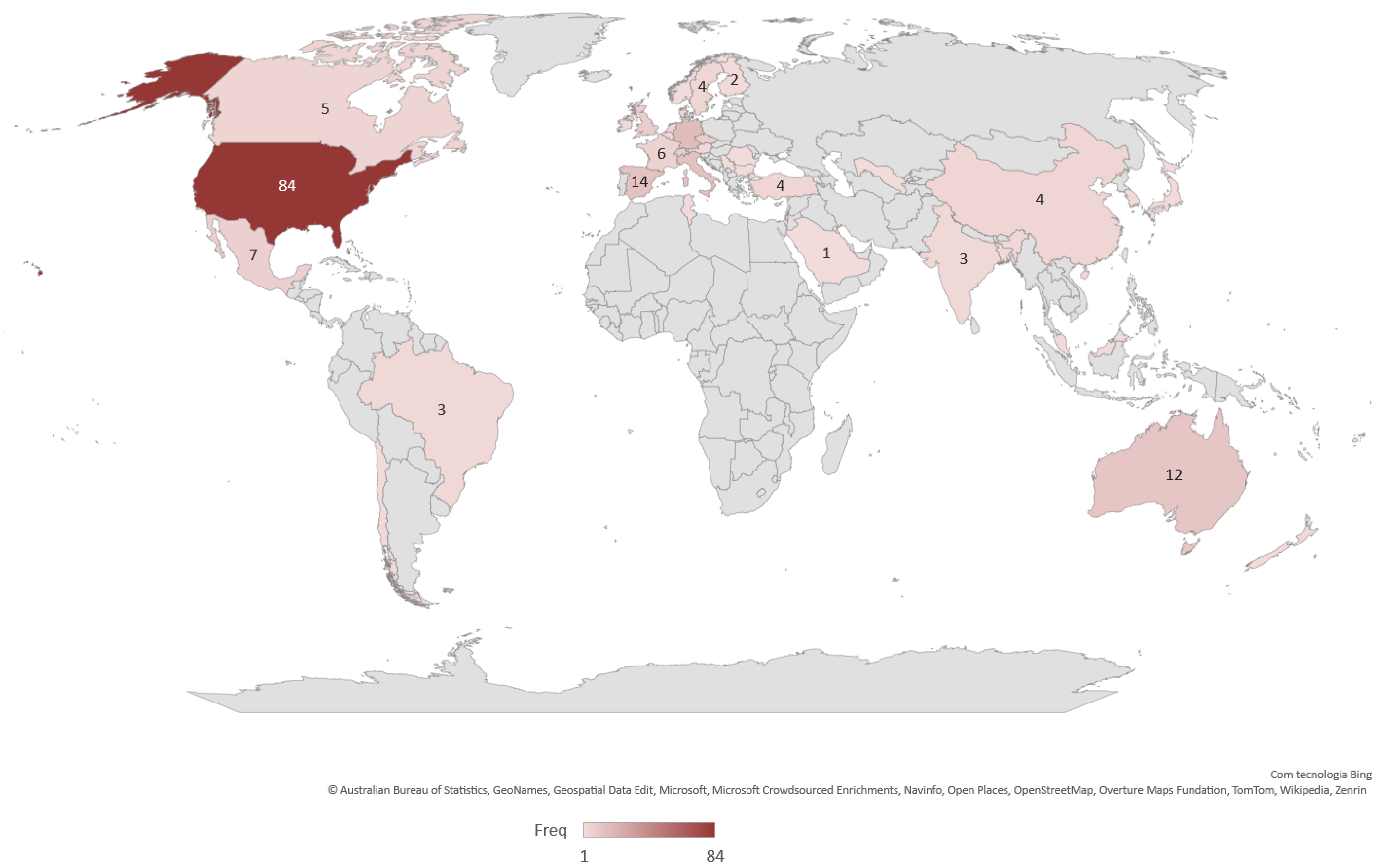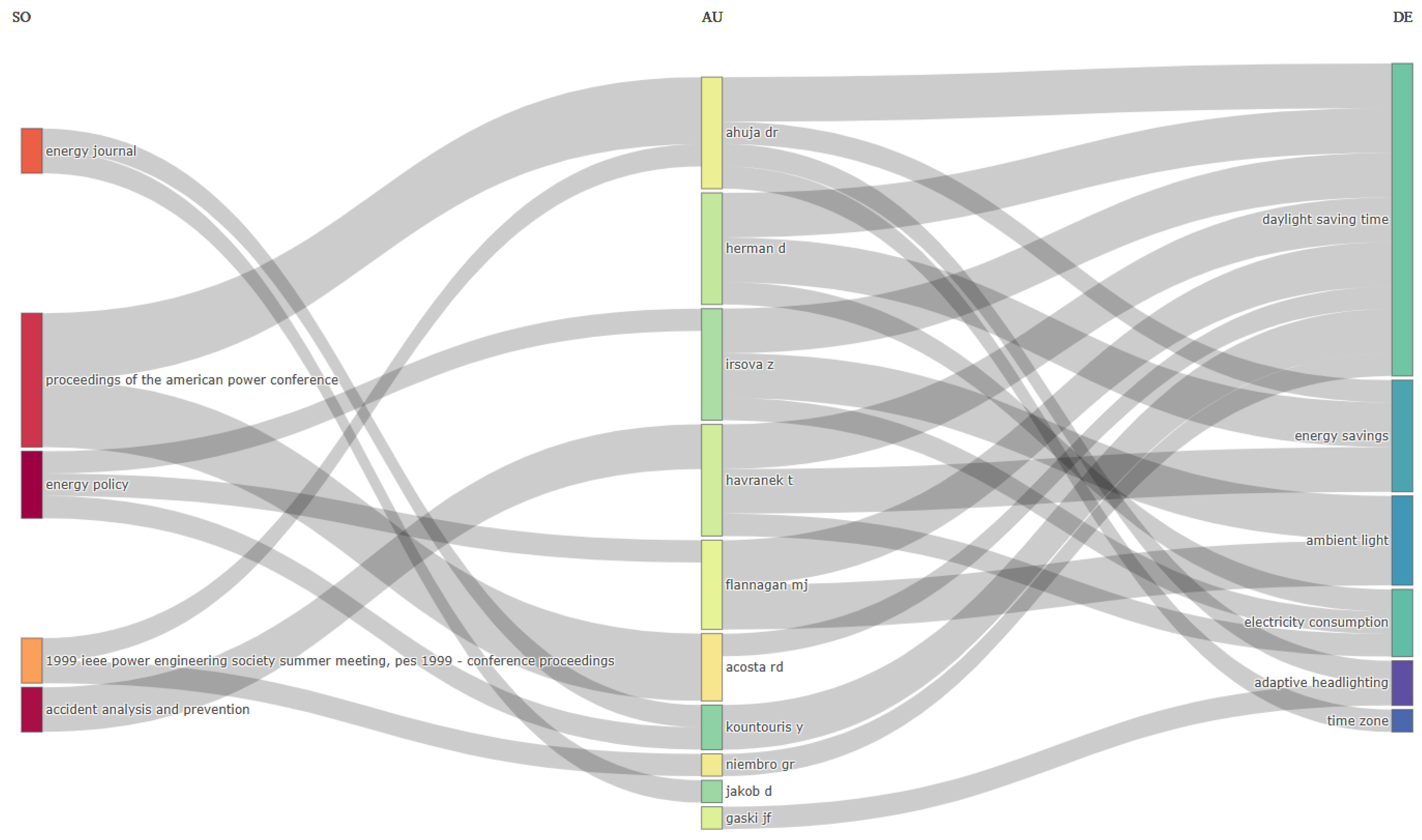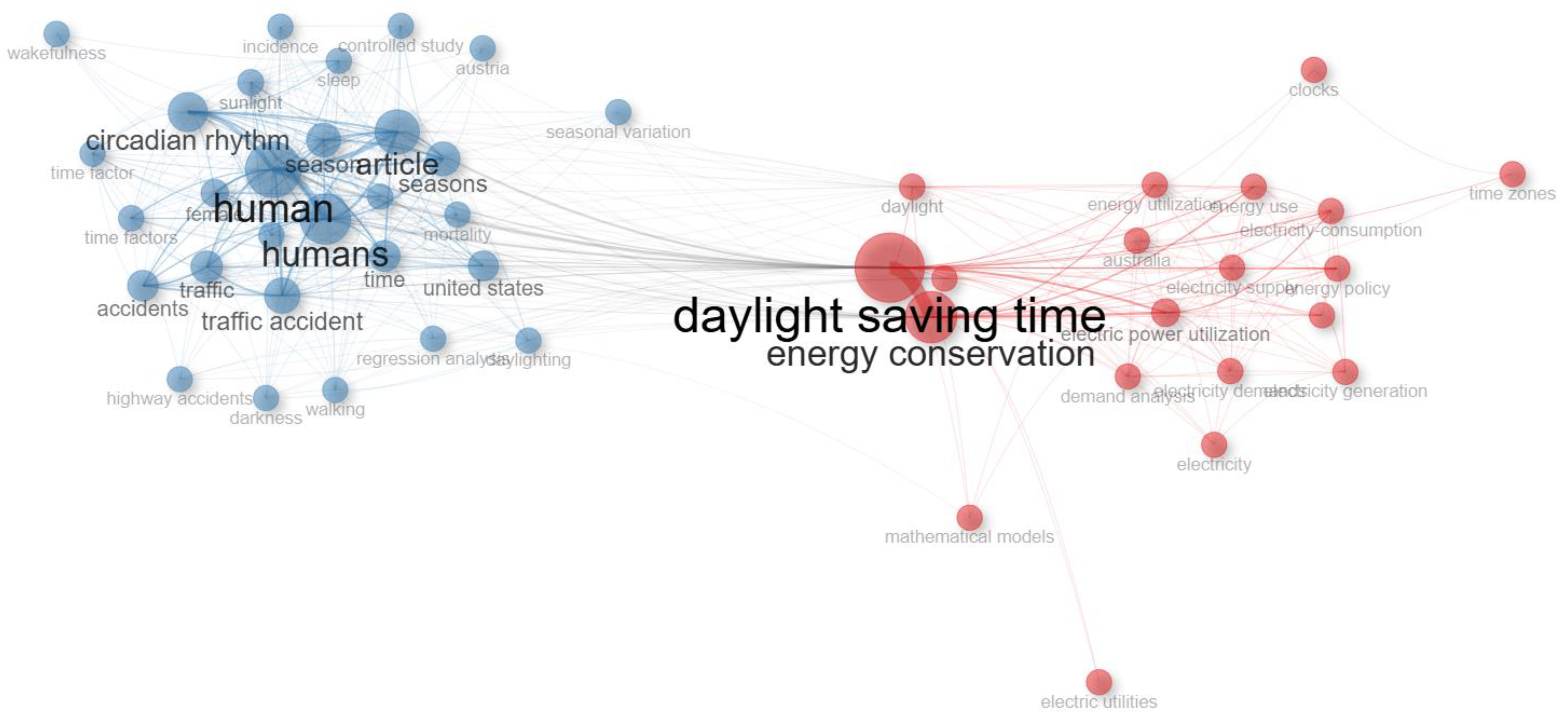The Impact of Daylight Saving Time on the Energy Efficiency of Buildings: A Bibliometric and General Review
Abstract
1. Introduction
2. Materials and Methods
2.1. Bibliometric Analysis Procedure
- -
- Data Collection: The first step involved collecting bibliographic data. For this analysis, a search was conducted in scientific databases using keywords relevant to the study topic. The records were exported in BibTeX format, compatible with Bibliometrix.
- -
- Data Preparation: The BibTeX files were imported into RStudio and directly loaded into the Biblioshiny interface. This step ensured the proper formatting and structuring of the data, allowing for the processing of bibliometric variables such as authors, titles, abstracts, keywords, and institutional affiliations.
- -
- Analysis Setup in Biblioshiny: In Biblioshiny, several relevant bibliometric analyses were configured:
- ○
- Scientific Production Analysis: This involved studying the annual productivity of articles on the topic, identifying publication trends over time.
- ○
- Authors and Institutions Analysis: Identification of the most productive authors and institutions, as well as their collaborations, through co-authorship graphs and collaborative networks.
- ○
- Keywords and Topic Analysis: Analysis of the most frequent keywords and main topics covered in the articles, conducted to understand the thematic focus of the research field.
- ○
- Network Mapping: Creation of network maps, including word co-occurrence networks, co-citation networks, and country collaboration networks, to illustrate the knowledge structure and connections in the studied area.
- -
- Data Analysis and Interpretation: With the analyses configured, Biblioshiny generated graphs and tables for each of the investigated dimensions. The graphical results were used to visualize citation, co-authorship, and keyword patterns, enabling the identification of research trends and gaps.
- -
- Export and Storage of Results: Finally, the results were exported directly from the Biblioshiny interface, in image and table formats, for further analysis and inclusion in the article.
2.2. Literature Review
- -
- Study Identification: After the bibliometric analysis using Biblioshiny, the main articles, themes, and authors in the field were identified. The bibliometric analysis allowed for visualization of publication trends, frequent keywords, and collaboration networks, resulting in an initial list of potentially relevant articles for the review.
- -
- Creation of the PRISMA Study Flow:
- ○
- Initial Search: The list of articles obtained from the bibliometric analysis was exported and imported into reference management software EndNote 21, where all studies were initially and formally identified for inclusion in the review.
- ○
- Removal of Duplicates: Duplicate records were removed, reducing the set of studies to be analyzed and increasing the efficiency of the selection process.
- ○
- Study Screening: Eligibility criteria were applied based on the titles and abstracts of the articles, considering relevance and alignment with the study objectives. At this stage, articles that did not meet the pre-established inclusion criteria, such as language, scope, and publication period, were excluded.
- -
- Study Selection:
- ○
- Full-Text Evaluation: The articles that passed screening were evaluated in full, following defined inclusion criteria, such as methodological quality, theoretical relevance, and alignment with the focus of the review. This selection process adhered to PRISMA guidelines, with each article independently evaluated by at least two reviewers to reduce bias.
- ○
- Application of Exclusion Criteria: Articles that did not contain relevant data or presented inadequate methodology for the review’s purposes were excluded. This stage ensured the inclusion of only high-quality studies directly related to the topic.
- -
- Data Extraction and Analysis:
- ○
- Extraction of Key Data: Relevant information was extracted from the included articles, such as author, year of publication, country, methodology, main findings, and conclusions. The extracted data were organized in a table to allow for a comparative view across studies.
- ○
- Thematic Analysis: Based on the keywords and recurring themes identified in the bibliometric analysis, main themes were defined to guide the discussion. This thematic analysis facilitated the identification of patterns, significant contributions, and knowledge gaps in the field.
- -
- Synthesis and Discussion: Finally, the results of the analysis were synthesized, emphasizing the main contributions, trends, and gaps identified in the literature, according to the bibliometric results. The PRISMA methodology contributed to a structured and rigorous presentation of the review, providing a clear view of existing approaches and potential areas for future research.
3. Bibliometric Analysis Results
3.1. Bibliometric Analysis of the Data
3.2. Analysis of Frequent Terms in DST Research
3.3. Evolution of Citations over the Years
3.4. Geographical Distribution of Research Output
3.5. Relationships Among Sourcess, Authors, and Keywords
3.6. Co-Occurrence Analysis of Keywords
4. Results and Discussion
4.1. DST Brief Historic Analysis
4.2. DST Without the Energy Component
4.3. Potential Energy Savings with DST
4.3.1. The Overall Impact of DST on Energy Efficiency
4.3.2. Regional Studies on the Impact of DST on Energy Demand
4.3.3. DST Impact on Energy Demand and Energy Consumption Profile
5. Conclusions
Author Contributions
Funding
Data Availability Statement
Acknowledgments
Conflicts of Interest
References
- Araújo, I.; Nunes, L.J.R.; Vilas, D.P.; Curado, A. Photovoltaic Production Management in a Hall of Residence with High Energy Consumption. Energies 2022, 15, 8412. [Google Scholar] [CrossRef]
- Verdejo, H.; Becker, C.; Echiburu, D.; Escudero, W.; Fucks, E. Impact of daylight saving time on the Chilean residential consumption. Energy Policy 2016, 88, 456–464. [Google Scholar] [CrossRef]
- Mirza, F.M.; Bergland, O. The impact of daylight saving time on electricity consumption: Evidence from southern Norway and Sweden. Energy Policy 2011, 39, 3558–3571. [Google Scholar] [CrossRef]
- Ahuja, D.R.; SenGupta, D. Year-round daylight saving time will save more energy in India than corresponding DST or time zones. Energy Policy 2012, 42, 657–669. [Google Scholar] [CrossRef]
- Flores, D.; Luna, E.M. An econometric evaluation of daylight saving time in Mexico. Energy 2019, 187, 116124. [Google Scholar] [CrossRef]
- Kellogg, R.; Wolff, H. Daylight time and energy: Evidence from an Australian experiment. J. Environ. Econ. Manag. 2008, 56, 207–220. [Google Scholar] [CrossRef]
- Kotchen, M.J.; Grant, L.E. Does Daylight Saving Time Save Energy? Evidence from a Natural Experiment in Indiana. Rev. Econ. Stat. 2011, 93, 1172–1185. [Google Scholar] [CrossRef]
- Marshall, D. El Consumo Eléctrico Residencial en Chile en 2008. Cuad. Econ. 2010, 47, 57–89. [Google Scholar] [CrossRef]
- Shimoda, Y.; Asahi, T.; Taniguchi, A.; Mizuno, M. Evaluation of city-scale impact of residential energy conservation measures using the detailed end-use simulation model. Energy 2007, 32, 1617–1633. [Google Scholar] [CrossRef]
- Kandel, A.; Sheridan, M. The Effect of Early Daylight Saving Time on California Electricity Consumption: A Statistical Analysis; California Energy Commission: Sacramento, CA, USA, 2007. [Google Scholar]
- European Commission. Proposal for a Directive of the European Parliament and of the Council Discontinuing Seasonal Changes of Time and Repealing Directive 2000/84/EC; European Commission: Brussels, Belgium, 2018. [Google Scholar]
- Aria, M.; Cuccurullo, C. Bibliometrix: An R-tool for comprehensive science mapping analysis. J. Informetr. 2017, 11, 959–975. [Google Scholar] [CrossRef]
- Franklin, B. An Economical Project. J. Paris 1784, 26, 1–4. Available online: https://founders.archives.gov/documents/Franklin/01-42-02-0151 (accessed on 16 April 2024).
- Douma, M. Curator. Daylight Saving Time. 2008. Available online: https://webexhibits.org/daylightsaving/ (accessed on 16 April 2024).
- Hudson, G.V. On Seasonal Time-Adjustment in Countries South of Lat. 30°. Transactions and Proceedings of the New Zealand Institute 1895. Volume 28, pp. 734–736. Available online: https://paperspast.natlib.govt.nz/periodicals/TPRSNZ1895-28.2.7.1.5 (accessed on 16 April 2024).
- Haines, J. Which Countries Observe Daylight Saving Time? US News & World Report, 6 November 2023. [Google Scholar]
- Pew Research Center. Most Countries Don’t Observe Daylight Saving Time; Pew Research Center: Washington, DC, USA, 2023; Available online: https://www.pewresearch.org/short-reads/2023/10/26/most-countries-dont-observe-daylight-saving-time/ (accessed on 16 April 2024).
- Rishi, M.A.; Ahmed, O.; Perez, J.H.B.; Berneking, M.; Dombrowsky, J.; Flynn-Evans, E.E.; Santiago, V.; Sullivan, S.S.; Upender, R.; Yuen, K.; et al. Daylight saving time: An American Academy of Sleep Medicine position statement. J. Clin. Sleep Med. 2020, 16, 1781–1784. [Google Scholar] [CrossRef] [PubMed]
- Manfredini, R.A.-O.; Fabbian, F.; Cappadona, R.; Modesti, P.A. Daylight saving time, circadian rhythms, and cardiovascular health. Intern. Emerg. Med. 2018, 13, 641–646. [Google Scholar] [CrossRef]
- Desmennu, A.T.; Titiloye, M.A.; Owoaje, E.T. Behavioural risk factors for sexually transmitted infections and health seeking behaviour of street youths in Ibadan, Nigeria. Afr. Health Sci. 2018, 18, 180–187. [Google Scholar] [CrossRef] [PubMed]
- Lambert, G.W.; Reid, C.; Kaye, D.M.; Jennings, G.L.; Esler, M.D. Effect of sunlight and season on serotonin turnover in the brain. Lancet 2002, 360, 1840–1842. [Google Scholar] [CrossRef] [PubMed]
- James, S.M.; Honn, K.A.; Gaddameedhi, S.; Van Dongen, H.P.A. Shift Work: Disrupted Circadian Rhythms and Sleep—Implications for Health and Well-being. Curr. Sleep Med. Rep. 2017, 3, 104–112. [Google Scholar] [CrossRef]
- Farrell, D.; Narasiman, V.; Ward, M. Shedding Light on Daylight Saving Time. Econom. Model. Macroecon. eJournal 2016. [Google Scholar] [CrossRef]
- Gibson, M.; Shrader, J. Time Use and Labor Productivity: The Returns to Sleep. Rev. Econ. Stat. 2018, 100, 783–798. [Google Scholar] [CrossRef]
- Giuntella, O.; Mazzonna, F. Sunset time and the economic effects of social jetlag: Evidence from US time zone borders. J. Health Econ. 2019, 65, 210–226. [Google Scholar] [CrossRef]
- Costa-Font, J.; Fleche, S.; Pagan, R. The labour market returns to sleep. J. Health Econ. 2024, 93, 102840. [Google Scholar] [CrossRef]
- Barnes, C.M.; Wagner, D.T. Changing to daylight saving time cuts into sleep and increases workplace injuries. J. Appl. Psychol. 2009, 94, 1305–1317. [Google Scholar] [CrossRef] [PubMed]
- Dickinson, A.; Waddell, G.R. Productivity losses in the transition to Daylight Saving Time: Evidence from hourly GitHub activity. J. Econ. Behav. Organ. 2024, 227, 106749. [Google Scholar] [CrossRef]
- Kountouris, Y.; Remoundou, K. About time: Daylight Saving Time transition and individual well-being. Econ. Lett. 2014, 122, 100–103. [Google Scholar] [CrossRef]
- Ferguson, S.A.; Preusser, D.F.; Lund, A.K.; Zador, P.L.; Ulmer, R.G. Daylight saving time and motor vehicle crashes: The reduction in pedestrian and vehicle occupant fatalities. Am. J. Public Health 1995, 85, 92–95. [Google Scholar] [CrossRef]
- Doleac, J.L.; Sanders, N.J. Under the Cover of Darkness: How Ambient Light Influences Criminal Activity. Rev. Econ. Stat. 2015, 97, 1093–1103. [Google Scholar] [CrossRef]
- Kamstra, M.J.; Kramer, L.A.; Levi, M.D. Losing Sleep at the Market: The Daylight Saving Anomaly. Am. Econ. Rev. 2000, 90, 1005–1011. [Google Scholar] [CrossRef]
- Müller, L.; Schiereck, D.; Simpson, M.; Voigt, C. Daylight saving effect. J. Multinatl. Financ. Manag. 2009, 19, 127–138. [Google Scholar] [CrossRef]
- Lahti, T.; Nysten, E.; Haukka, J.; Sulander, P.; Partonen, T. Daylight saving time transitions and road traffic accidents. J. Environ. Public Health 2010, 2010, 657167. [Google Scholar] [CrossRef]
- Toro, W.; Tigre, R.; Sampaio, B. Daylight Saving Time and incidence of myocardial infarction: Evidence from a regression discontinuity design. Econ. Lett. 2015, 136, 1–4. [Google Scholar] [CrossRef]
- Shapiro, C.M.; Blake, F.; Fossey, E.; Adams, B. Daylight saving time in psychiatric illness. J. Affect. Disord. 1990, 19, 177–181. [Google Scholar] [CrossRef]
- Kuehnle, D.; Wunder, C. Using the Life Satisfaction Approach to Value Daylight Savings Time Transitions: Evidence from Britain and Germany. J. Happiness Stud. 2016, 17, 2293–2323. [Google Scholar] [CrossRef]
- Henry, O. Average sunrise time predicts depression prevalence. J. Psychosom. Res. 2003, 55, 99–105. [Google Scholar] [CrossRef]
- Prerau, D.S. Changing Times: National Time Management Policy. Technol. Rev. 1977, 79, 54–63. [Google Scholar]
- Rock, B.A. Impact of daylight saving time on residential energy consumption and cost. Energy Build. 1997, 25, 63–68. [Google Scholar] [CrossRef]
- Aries, M.B.; Newsham, G.R. Effect of daylight saving time on lighting energy use: A literature review. Energy Policy 2008, 36, 1858–1866. [Google Scholar] [CrossRef]
- Havranek, T.; Herman, D.; Irsova, Z. Does Daylight Saving Save Electricity? A Meta-Analysis. Energy J. 2018, 39, 63–86. [Google Scholar] [CrossRef]
- Littlefair, P.F. Effects of clock change on lighting energy use. Energy World 1990, 175, 15–17. [Google Scholar]
- Hill, S.; Desobry, F.; Garnsey, E.; Chong, Y.-F. The impact on energy consumption of daylight saving clock changes. Energy Policy 2010, 38, 4955–4965. [Google Scholar] [CrossRef]
- Kudela, P.; Havranek, T.; Herman, D.; Irsova, Z. Does daylight saving time save electricity? Evidence from Slovakia. Energy Policy 2020, 137, 111146. [Google Scholar] [CrossRef]
- Grujic, M.; Radevski, A. Simple analysis of daylight saving time effects in Belgrade climate and latitude. Spatium 2018, 2018, 1–6. [Google Scholar] [CrossRef]
- López, M. Daylight effect on the electricity demand in Spain and assessment of Daylight Saving Time policies. Energy Policy 2020, 140, 111419. [Google Scholar] [CrossRef]
- Eggimann, S.; Mutschler, R.; Orehounig, K.; Fiorentini, M. Climate change shifts the trade-of between lower cooling and higher heating demand from daylight saving time in office buildings. Environ. Res. Lett. 2023, 18, 024001. [Google Scholar] [CrossRef]
- Giacomelli-Sobrinho, V.; Cudlínová, E.; Buchtele, R.; Sagapova, N. The tropical twilight of Daylight-Saving Time (DST): Enlightening energy savings from electricity markets across Brazilian regions. Energy Sustain. Dev. 2022, 67, 81–92. [Google Scholar] [CrossRef]
- Fong, W.-K.; Matsumoto, H.; Lun, Y.-F.; Kimura, R. Energy Savings Potential of the Summer Time Concept in Different Regions of JapanFrom the Perspective of Household Lighting. J. Asian Archit. Build. Eng. 2007, 6, 371–378. [Google Scholar] [CrossRef]
- Momani, M.A.; Yatim, B.; Ali, M.A.M. The impact of the daylight saving time on electricity consumption-A case study from Jordan. Energy Policy 2009, 37, 2042–2051. [Google Scholar] [CrossRef]
- Karasu, S. The effect of daylight saving time options on electricity consumption of Turkey. Energy 2010, 35, 3773–3782. [Google Scholar] [CrossRef]
- Krarti, M.; Hajiah, A. Analysis of impact of daylight time savings on energy use of buildings in Kuwait. Energy Policy 2011, 39, 2319–2329. [Google Scholar] [CrossRef]
- Belzer, D.B.; Hadley, S.W.; Chin, S.-M. Impact of Extended Daylight Saving Time on National Energy Consumption Report to Congress; DOEEE (USDOE Office of Energy Efficiency and Renewable Energy (EE)): Washington, DC, USA, 2008. [Google Scholar]
- Kandel, A.; Metz, D. The Effects of Daylight Saving Time on California Electricity Use; California Energy Commission: Sacramento, CA, USA, 2001. [Google Scholar]
- Niembro, G.; Acosta, R. A methodology to classify residential customers by their pattern of consumption. In Proceedings of the 1999 IEEE Power Engineering Society Summer Meeting, PES 1999-Conference Proceedings, Edmonton, AB, Canada, 18–22 July 1999; pp. 226–231. [Google Scholar]
- Hillman, M.; Parker, J. More daylight, less electricity. Energy Policy 1988, 16, 514–515. [Google Scholar] [CrossRef]
- Küfeoğlu, S.; Üçler, Ş.; Eskicioğlu, F.; Öztürk, E.B.; Chen, H. Daylight Saving Time policy and energy consumption. Energy Rep. 2021, 7, 5013–5025. [Google Scholar] [CrossRef]
- Choi, S.; Pellen, A.; Masson, V. How does daylight saving time affect electricity demand? An answer using aggregate data from a natural experiment in Western Australia. Energy Econ. 2017, 66, 247–260. [Google Scholar] [CrossRef]
- Grigor’ev, V.S.; Lishak, E.Y.; Onegina, O.O. Domestic Power Consumption in Moscow. Svetotehnika 1984, 6–7. [Google Scholar]
- Guven, C.; Yuan, H.; Zhang, Q.; Aksakalli, V. When does daylight saving time save electricity? Weather and air-conditioning. Energy Econ. 2021, 98, 105216. [Google Scholar] [CrossRef]
- Bergland, O.; Mirza, F. Latitudinal Effect on Energy Savings from Daylight Savings Time; School of Economics and Business, Norwegian University of Life Sciences: Ås, Norway, 2017. [Google Scholar]
- Bircan, Ç.; Wirsching, E. Daylight saving all year round? Evidence from a national experiment. Energy Econ. 2023, 127, 107093. [Google Scholar] [CrossRef]





| Description | Results |
|---|---|
| Timespan | 1968:2023 |
| Sources (journals, books, etc.) | 109 |
| Documents | 139 |
| Annual growth rate % | 2.02 |
| Document average age | 13.1 |
| Average citations per doc | 15 |
| References | 3638 |
| Document contents | |
| Keywords Plus (ID) | 1066 |
| Author’s Keywords (DE) | 293 |
| Authors | |
| Authors | 360 |
| Authors of single-authored docs | 35 |
| Authors collaboration | |
| Single-authored docs | 38 |
| Co-authors per doc | 2.76 |
| International co-authorships % | 16.55 |
| Document type | |
| Article | 100 |
| Conference paper | 31 |
| Conference review | 1 |
| Erratum | 1 |
| Note | 1 |
| Review | 4 |
| Short survey | 1 |
| Year | MeanTCperArt | N | MeanTCperYear | CitableYears |
|---|---|---|---|---|
| 1968 | 16 | 1 | 0.29 | 56 |
| 1976 | 32.5 | 2 | 0.68 | 48 |
| 1977 | 0 | 1 | 0 | 47 |
| 1978 | 14 | 1 | 0.3 | 46 |
| 1979 | 14 | 1 | 0.31 | 45 |
| 1980 | 0 | 1 | 0 | 44 |
| 1981 | 0 | 1 | 0 | 43 |
| 1984 | 0 | 1 | 0 | 40 |
| 1987 | 0 | 1 | 0 | 37 |
| 1989 | 6.25 | 4 | 0.18 | 35 |
| 1990 | 3 | 2 | 0.09 | 34 |
| 1993 | 6 | 1 | 0.19 | 31 |
| 1994 | 0 | 1 | 0 | 30 |
| 1995 | 0 | 1 | 0 | 29 |
| 1996 | 1.5 | 2 | 0.05 | 28 |
| 1997 | 10.67 | 3 | 0.4 | 27 |
| 1999 | 4 | 1 | 0.16 | 25 |
| 2000 | 11.67 | 3 | 0.49 | 24 |
| 2002 | 78 | 2 | 3.55 | 22 |
| 2003 | 2 | 1 | 0.1 | 21 |
| 2004 | 26.5 | 2 | 1.32 | 20 |
| 2005 | 0 | 2 | 0 | 19 |
| 2006 | 8 | 1 | 0.44 | 18 |
| 2007 | 16.6 | 5 | 0.98 | 17 |
| 2008 | 41.25 | 4 | 2.58 | 16 |
| 2009 | 12.5 | 2 | 0.83 | 15 |
| 2010 | 17.5 | 8 | 1.25 | 14 |
| 2011 | 88.75 | 8 | 6.83 | 13 |
| 2012 | 11.33 | 6 | 0.94 | 12 |
| 2013 | 12 | 2 | 1.09 | 11 |
| 2014 | 10.25 | 4 | 1.02 | 10 |
| 2015 | 3 | 1 | 0.33 | 9 |
| 2016 | 26 | 4 | 3.25 | 8 |
| 2017 | 11 | 5 | 1.57 | 7 |
| 2018 | 7.33 | 9 | 1.22 | 6 |
| 2019 | 3.9 | 10 | 0.78 | 5 |
| 2020 | 9.45 | 11 | 2.36 | 4 |
| 2021 | 1.29 | 14 | 0.43 | 3 |
| 2022 | 0.14 | 7 | 0.07 | 2 |
| 2023 | 0 | 3 | 0 | 1 |
Disclaimer/Publisher’s Note: The statements, opinions and data contained in all publications are solely those of the individual author(s) and contributor(s) and not of MDPI and/or the editor(s). MDPI and/or the editor(s) disclaim responsibility for any injury to people or property resulting from any ideas, methods, instructions or products referred to in the content. |
© 2025 by the authors. Licensee MDPI, Basel, Switzerland. This article is an open access article distributed under the terms and conditions of the Creative Commons Attribution (CC BY) license (https://creativecommons.org/licenses/by/4.0/).
Share and Cite
Araújo, I.; Nunes, L.J.R.; Vilas, D.P.; Curado, A. The Impact of Daylight Saving Time on the Energy Efficiency of Buildings: A Bibliometric and General Review. Energies 2025, 18, 2088. https://doi.org/10.3390/en18082088
Araújo I, Nunes LJR, Vilas DP, Curado A. The Impact of Daylight Saving Time on the Energy Efficiency of Buildings: A Bibliometric and General Review. Energies. 2025; 18(8):2088. https://doi.org/10.3390/en18082088
Chicago/Turabian StyleAraújo, Ivo, Leonel J. R. Nunes, David Patíño Vilas, and António Curado. 2025. "The Impact of Daylight Saving Time on the Energy Efficiency of Buildings: A Bibliometric and General Review" Energies 18, no. 8: 2088. https://doi.org/10.3390/en18082088
APA StyleAraújo, I., Nunes, L. J. R., Vilas, D. P., & Curado, A. (2025). The Impact of Daylight Saving Time on the Energy Efficiency of Buildings: A Bibliometric and General Review. Energies, 18(8), 2088. https://doi.org/10.3390/en18082088









